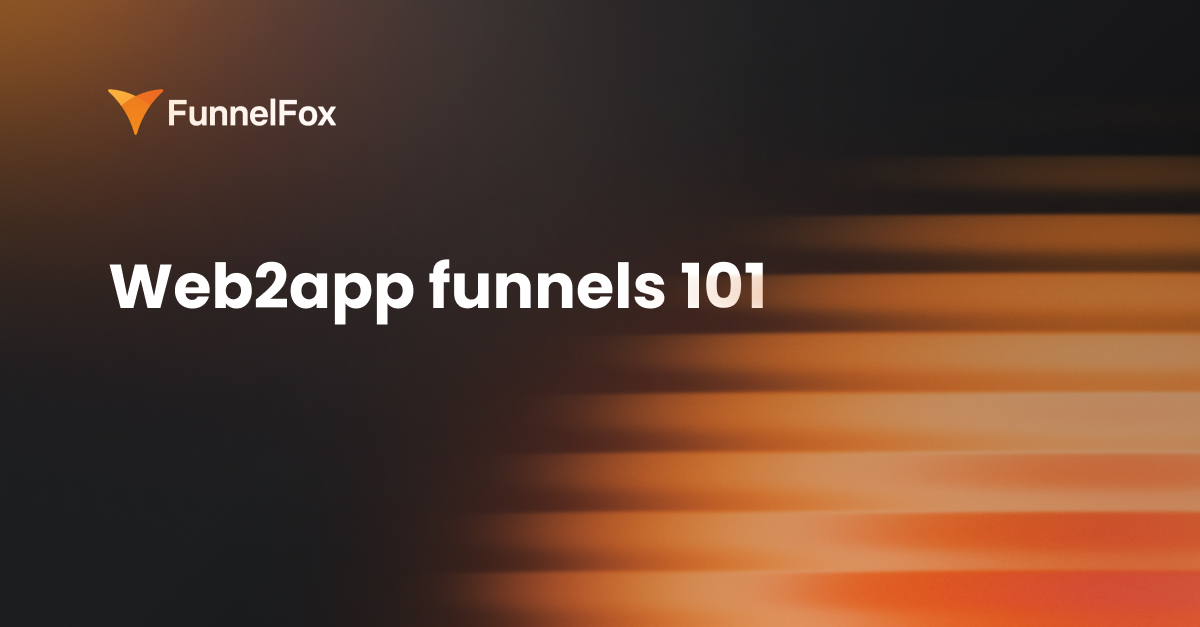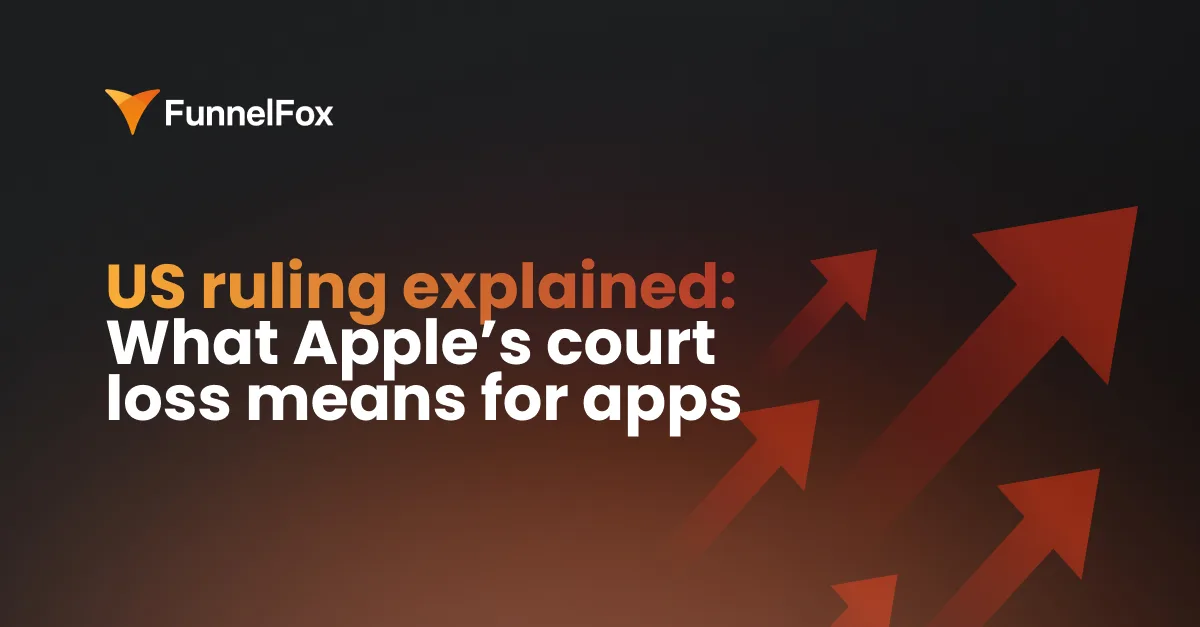Whatever the question is about web2app that brought you in, you’re in the right place. You’ll learn what web2app funnel is, why more apps are switching to it, how to tell if it fits your product, how to build and scale a working funnel, and what top teams are doing differently.
What is a web2app funnel?
A web2app funnel lets you acquire, onboard, and convert users on the web before they land in the app store.
With the traditional direct-to-app approach, traffic goes straight from ad to store. From there, users download the app, go through onboarding, create an account, and maybe convert.
Web2app funnel flips the sequence. You guide users through the full journey in the browser: discovery, onboarding, and payment. Only after the purchase do they download the app, with their subscription already active.

How a web2app funnel works:
- A user taps your ad and lands on a landing page.
- They complete onboarding (often a quiz that collects goals, preferences, and context).
- After onboarding, they see a paywall with a personalized offer based on the quiz results.
- They check out on the web using their preferred payment method (card, PayPal, Apple Pay, etc.). That method is saved and used for future renewals, upgrades, and cancellations, all handled on the web, too.
- After payment, the user receives a unique link that redirects them to the app store. They install the app, sign in, and immediately access their purchase — no extra steps.
The entire process — from click to active user — takes a few minutes, depending on onboarding length. The app store in this flow becomes a handoff, and all monetization happens on the web.
Key benefits of using a web2app funnel
Over the past year, web2app funnels have quietly moved from an alternative UA tactic to a core strategy for apps like Flo, Headway, and BetterMe. Marketers are reallocating serious budgets as they’re recognizing web2app benefits: in 2024, web-based UA spend grew over 50%. And here’s why:
1. You get full data and precise attribution
Web2app funnel restores visibility lost to SKAN and ATT. Every click, view, and conversion happens in a space you fully control, so you know exactly where users come from, how they move through the funnel, and what drives them to convert.
And because the entire flow runs on the web, you can make changes instantly, without waiting for store’s review.
2. You keep more revenue (and get it faster)
Stores take 15–30%, web payments — just 2–5%. And payouts arrive in days, not weeks, so you can reinvest and scale faster.
The web also lets you experiment with offers, pricing models, and cancellation flows without store approvals.

Real-world example: Shmoody, a mood & habit tracker, switched to web2app with FunnelFox. Instead of waiting months for a dev build, the growth team launched and iterated on their own with pre-built blocks. In just three months, they boosted ROAS by +80% and doubled their UA budget — all while freeing developers to focus on the core app.
→ Click here to read the full story.
3. You unlock new user acquisition channels
Where do you usually run ads for direct-to-app? With web2app funnel, you can keep those and also access new UA channels (we’ll go over them in detail a bit further down) that just aren’t available for direct-to-app flows. On top of that, you can use UTMs for proper tracking.
Plus, web2app opens up a much bigger audience. Web and app users only overlap by around 15%, so there’s a lot of new ground (if you’re ready to scale).
4. You control the full user experience
App stores compress your story into a few screenshots and a short description. The web lets you personalize the journey, tailor the onboarding, adjust messaging, and A/B test every step of the funnel.
5. Your team moves faster
Growth teams test and iterate fast, and web2app supports that. It frees your team from app store bottlenecks, so you can ship, learn, and win faster.
6. You can quickly validate ideas before building
Web2app funnel isn’t just for user acquisition — it’s also a way to test product direction before you spend on development. Instead of guessing or running long research cycles, you can highlight a feature in the funnel and see if people respond. That data helps cut features that won’t pay off and double down on the ones that matter.
Real-world example: ExploreApps, a multi-product publisher, used a web2app funnel to validate demand for features in their AI music app. Unsure if users really cared about “cover song generation,” they tested it directly in the funnel flow. The experiment confirmed strong interest, which gave the team confidence to prioritize this feature — while also cutting CPS by 1.5× compared to app store campaigns.
→ Click here to read the full story.
When a web2app funnel makes sense: 6 signs
They’re not for every app or every use case, but there are clear moments when web2app funnel gives you an edge.
1. Your app falls into one of these categories
Some app categories naturally benefit from a richer pre-install experience, where trust, context, or personalization drive the decision to download:
- Health & fitness
- Education & learning
- Fashion & personal care
- Lifestyle & self-discovery
- Finance & productivity
Web2 app funnels also work well for B2B tools, utilities, photo/video apps, and even games when there’s a need to show value, build momentum, or smooth the path to install.
2. Your traffic comes from beyond the store
Not every user discovers your app through the app store. Some come from search, blogs, newsletters, or niche communities. When the first touchpoint is content-driven, a landing page and web onboarding give you more space to shape the story before asking for an install.
3. You’re testing offers, pricing, or positioning
Web flows let you test faster and with more control. If you’re experimenting with different value props, monetization models, or messaging angles, it’s much easier to do that outside the store.
4. You need control over billing or retention
Some users need invoices or alternate payment methods. Others churn unless you offer a pause or downgrade option at the right time. These flows are hard to build inside the store. On the web, you can control each one.
5. You rely on performance marketing
Web2app restores attribution and event-level data that helps your paid campaigns work. You see what users click, what they skip, and what converts. You can iterate faster, with better signals for optimization. This visibility is particularly important for teams running at scale with many traffic sources.
6. You’re designing around the user, not the install
There’s no universal funnel that works for every app. If you’re willing to tailor the experience based on where the user starts and what they need, web2app funnel gives you that flexibility.
Examples: How top apps apply the web2app strategy
Looking at how top apps approach web2app helps surface patterns that work across categories and stages. Here are some of the most common strategies:
1. One app, many funnels
Top teams don’t stop at one flow. They segment by user intent, entry point, or even topic to match the message to the moment.
For instance, BetterMe runs multiple funnels tailored to specific audience segments but pointing to the same product.

Real-world example: Glam AI, an AI photo & video app, matched each creative concept with its own funnel. Their first web2app funnel went live in just a day, and today the team builds new flows in 1–2 weeks. The shift saved them 30% on App Store fees and made creative-led funnels their main growth strategy.
→ Click here to read the full story.
2. Quizzes evolve into interactive onboarding
What used to be a simple Q&A now includes actions like tapping the screen or using the camera. Engagement goes up, and even if completion drops slightly, conversions often improve. People remember what they interacted with.
Duolingo, for example, lets users go through onboarding and even complete a full first lesson directly on the web. It’s not just a teaser, but rather a functional experience. That level of depth builds trust, sets expectations, and makes the install feel like a continuation, not a leap.

Another case: some of Nebula’s onboardings include over 50 questions. But the flow is structured like a conversation — animated, responsive, and paced. Users stay engaged not because it’s short, but because it feels tailored. And that engagement pays off in conversions.
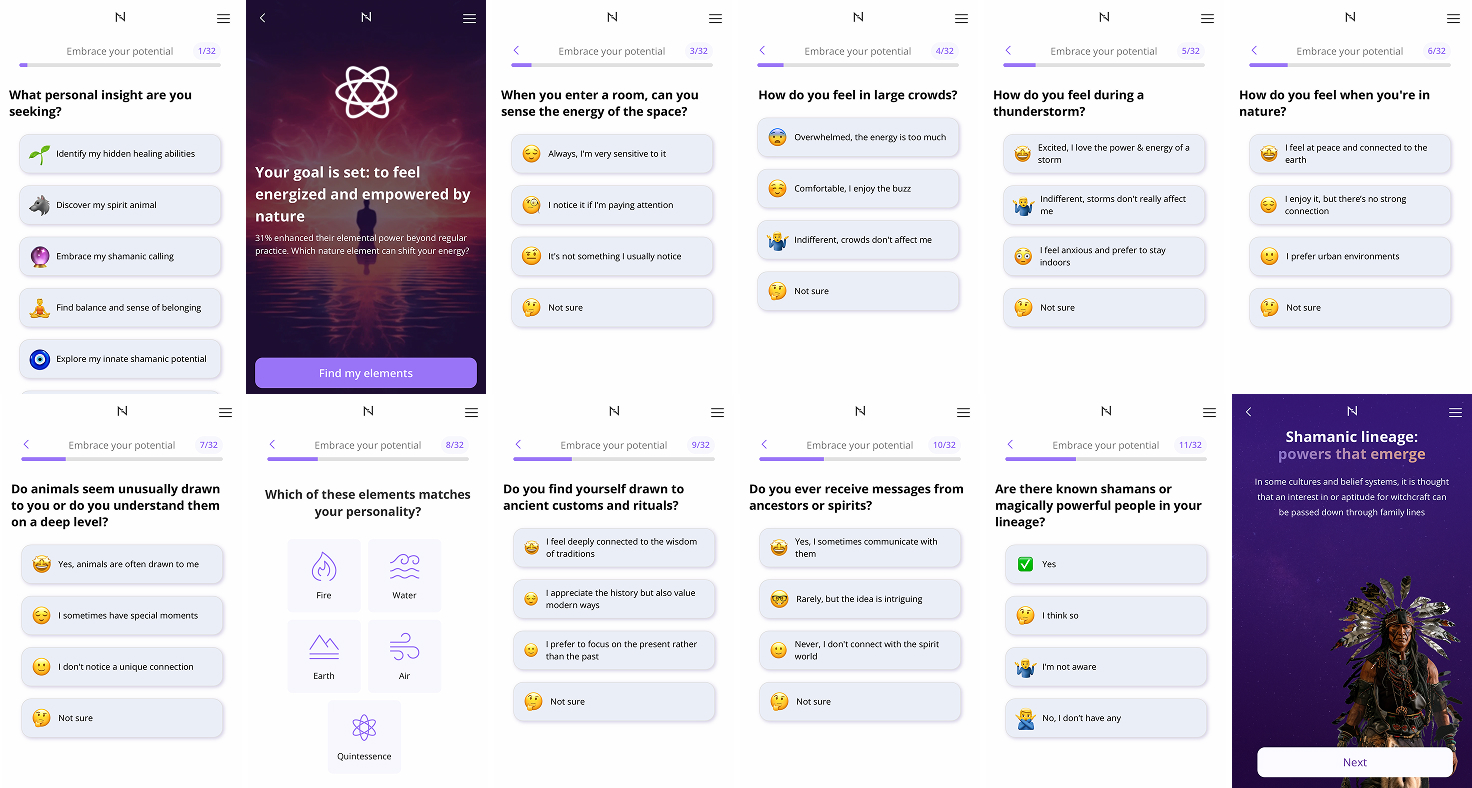
3. Intro offers work better than free trials
Instead of offering “7 days free,” many funnels now start with a 50–70% discount on the first billing period. Small upfront commitments paired with tiered paywalls lead to higher conversions and better retention than no-commitment trials.
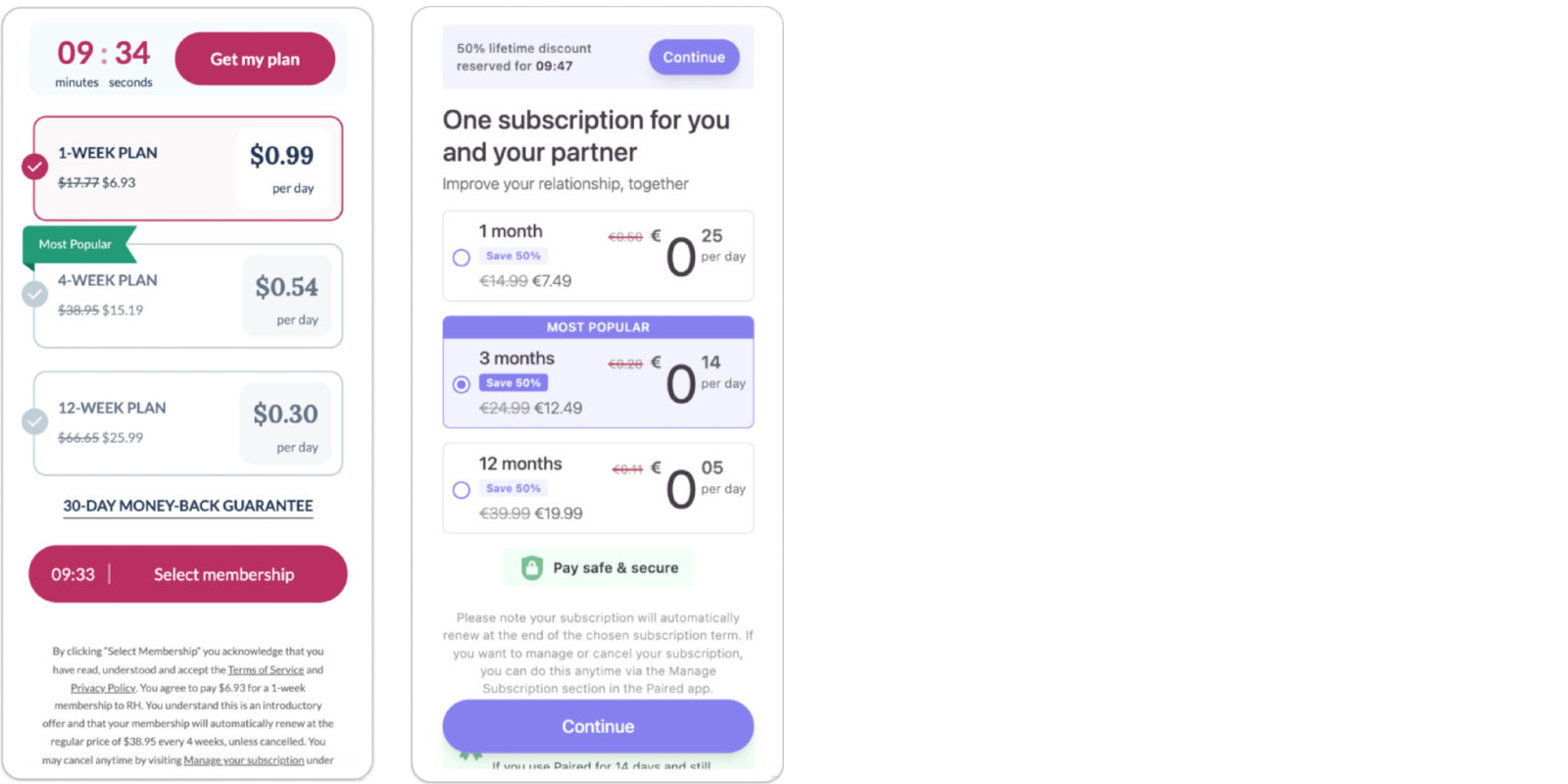
4. Apple Pay becomes the default
Now that WKWebView supports Apple Pay, more apps default to it on iOS. It’s fast, familiar, and often outperforms card or PayPal options in both conversion and user satisfaction.
💡 Setting Apple Pay as the default pre-selected payment option on the checkout gives up to +20% to CR.
5. Monetization doesn’t stop at checkout
Apps are extending their funnels past payment. Noom, for example, has 25 post-purchase screens and multiple one-click upsells. You don’t need dozens of upsells, but adding even one can lift LTV meaningfully.

💡 The higher the subscription price, the higher the upsell conversion.
About 20-30% can be upsold on top of your subscriptions.
6. TikTok leads the charge
TikTok has become a top channel for driving web2app traffic. Instead of pushing direct installs, many teams use short videos to spark interest and lead into interactive onboarding flows. For some, it’s now outperforming Meta on both reach and cost-efficiency.
How to build your first web2app funnel from scratch
1. Set up your team
You don’t need a big team to start with web2app funnel, but you do need the right roles covered. At a minimum:
- UA Manager: runs paid campaigns, handles targeting, and scales channels
- Product Marketer: owns onboarding, messaging, and monetization flows
- Designer: creates landing pages, paywalls, and ads that convert
- Developer or funnel builder: assembles and launches the actual flow
- Analyst: sets up tracking and helps turn funnel data into decisions
Real-world example: English on Smartphone started as a side project run by just three people — a teacher, a marketer, and a developer. With FunnelFox, they built their first funnel in a few evenings. The result: 2× revenue while cutting ad spend in half, plus an extra 10% from simple upsells.
→ Click here to read the full story.
💡 Early-stage teams often combine roles. And with a web2app funnel builder like FunnelFox, you can launch with just two people (UA and a designer) sharing roles part-time.
2. Pick your UA channels and prep creatives
The channels you choose shape how your funnel performs and what kind of creatives and flows you’ll need. For most teams, performance starts with a few core platforms (we’ll break them down in the table below). But once those are working, expansion often comes from the edges.
Here’s the overview of the key web2app UA channels:
| Channel | Strengths | Creative tips | Bidding & targeting | Scaling strategy |
|---|---|---|---|---|
| Meta (FB/IG) | Easy setup, broad reach, strong algorithmic optimization | 1 creative → 1 ad set → 1 campaign; test Purchase vs Leads | Broad targeting, Autobid / Cost Cap | Vertical + Horizontal scaling |
| TikTok | High engagement, great for UGC-style, fast experimentation | Refresh often; separate campaign per creative | Broad targeting, Autobid + Maximize Convs | Duplicate winners, use TCC |
| Google Ads | Massive reach across ecosystem (Search, YouTube, Play, etc.) | Strong creative required; segment by placement | Asset-based campaigns, algorithmic targeting | Needs learning budget & patience |
| Apple Search Ads | High-intent traffic directly in App Store | Use custom creatives & keywords in Advanced mode | Basic: CPI / Advanced: CPT + keyword control | Great for brand and keyword targeting |
Other web2app-friendly channels worth knowing about are:
- Pinterest works well for visual-first categories like wellness and lifestyle.
- Reddit lets you reach specific communities with high-intent targeting via subreddits.
- Snapchat and X (formerly Twitter) offer reach, but often come with higher CPMs.
- Spotify combines audio and video to support storytelling-driven funnels.
- In-app ad networks (like AppLovin, ironSource, Vungle) let you place ads inside other apps using formats like playables, rewarded videos, or interstitials, which are good for performance at scale.
- Content discovery platforms like Taboola and Outbrain are useful when your funnel is story-driven. Think pre-landers, quiz pages, or lightweight advertorials.
- Affiliate and CPA networks (like Impact, Affise, Everflow) let you pay only when users act. With the right tracking setup, they can add volume efficiently.
Each of these requires a tailored creative approach and a landing experience that fits the context, but when matched well, they can unlock entirely new user segments.
Creatives make it work
Then come the assets. Creatives burn out fast, and there’s no guaranteed winner. The only way to stay ahead is to ship and test creatives fast and scale what works.
Where to find creative ideas for web2app campaigns:
- Competitor ads & ad libraries
- JTBD interviews, quizzes, and onboarding flows
- Search trends, reviews, Reddit threads
- AI tools: ChatGPT, Midjourney, Runway, Arcads, etc.
What to test:
- Angles: problem/solution, emotional hooks, product benefits
- Formats: video, static, UGC, lo-fi, animated
- CTAs: short, curious, direct
You don’t need dozens of variations per week. But you do need a repeatable process: generate, ship, test, review, repeat.
3. Build web onboarding
Web onboarding is what happens between the ad click and the paywall — and it’s one of the biggest levers in your funnel. A good onboarding flow does three things: captures attention, builds motivation, and makes the offer feel relevant.
Here’s what to keep in mind when designing it:
1. Match the entry point. The first screen should reflect the promise made in the ad. Users need to feel they landed in the right place.

2. Ask questions with a purpose. Use a quiz to learn about user goals, pains, and preferences — but make sure each answer shapes what follows.

3. Respond to input. When users give you something, give feedback. It can be a progress bar, a plan preview, or even a small tip.

4. Build trust early. Use testimonials, brand logos, or user stats to reassure and anchor expectations.

5. Preview the value. Before showing the paywall, let users glimpse what they’ll get — this can be a personal plan, insight summary, or curated result.
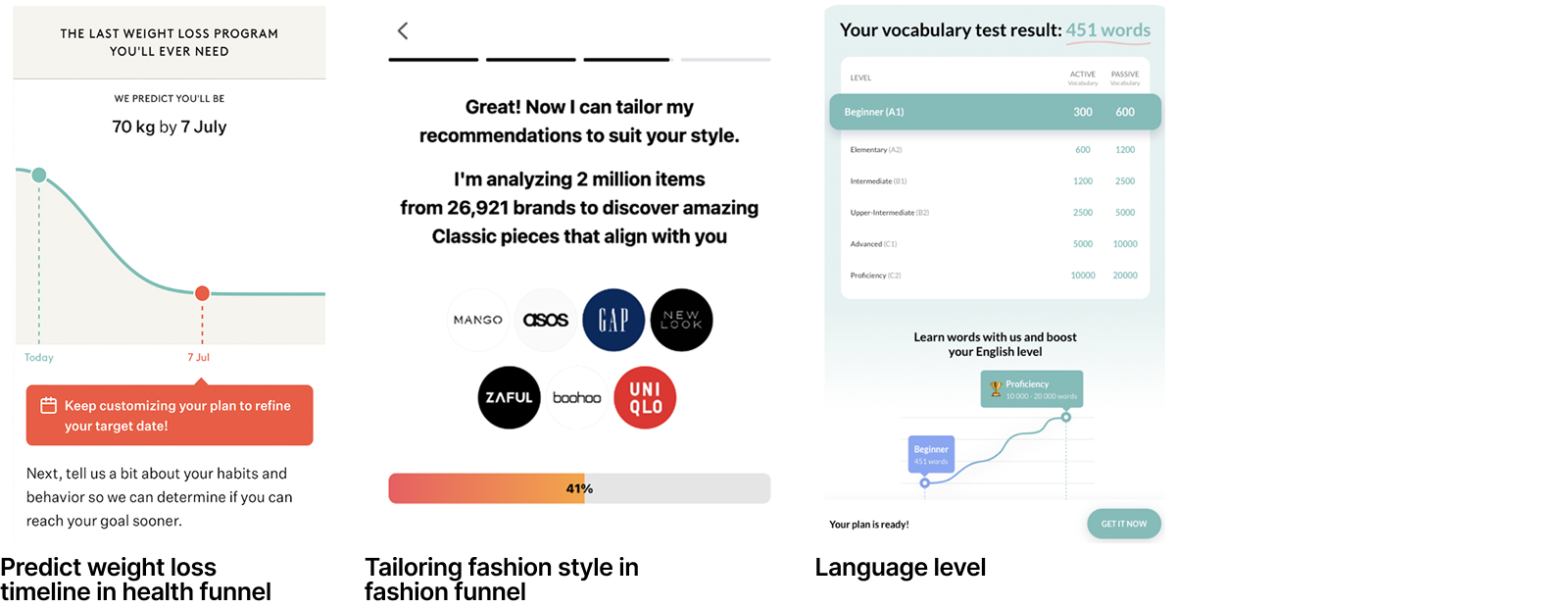
If the flow feels like a guided, valuable experience, you’re on the right track.
💡 Need ideas for web onboarding? Spy on competitors’ quizzes, deconstruct flows from other verticals, and use a web2app builder to launch quickly.
4. Set up monetization flow: paywall, checkout, and upsells
Once users complete onboarding, it’s time to convert. That means showing the right offer, at the right time, in a format that builds trust. Here’s how you configure a good web2app payments flow.
Paywall: frame the offer
By the time users see the paywall, they’ve already invested time. The goal is to make the decision easy.
- Personalize the offer using quiz data (e.g., custom plans, goals, or visuals).
- Structure the plan options clearly — three tiers work best (e.g., 1–3–12 months).
- Use a clear structure: three-tier plans (e.g., 1-3-12 months) tend to convert best.
- Support the decision with trust elements: reviews, guarantees, payment logos, secure design.
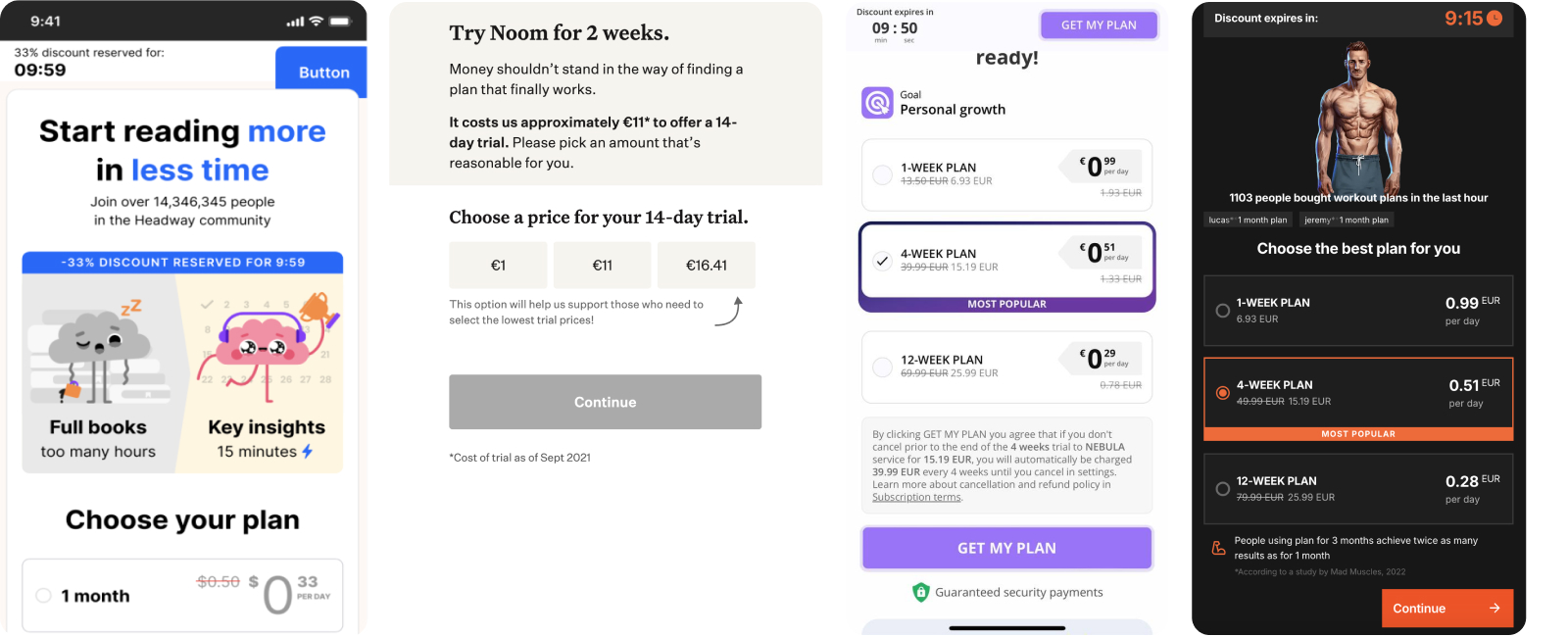
It’s also important to pick the right pricing logic:
- Intro offer → low first term, full renewal later
- Paid trial → small upfront, better post-trial CR
- Free trial → easy entry, lower conversion post-trial
Checkout: remove friction
Your checkout flow needs to be:
- Simple: as few fields as possible
- Fast: one-click options like Apple Pay
- Trustworthy: badges, secure icons, and clean design
- Native: don’t redirect, use overlays or embedded flows
💡 Custom checkouts convert up to 30% better than default ones.
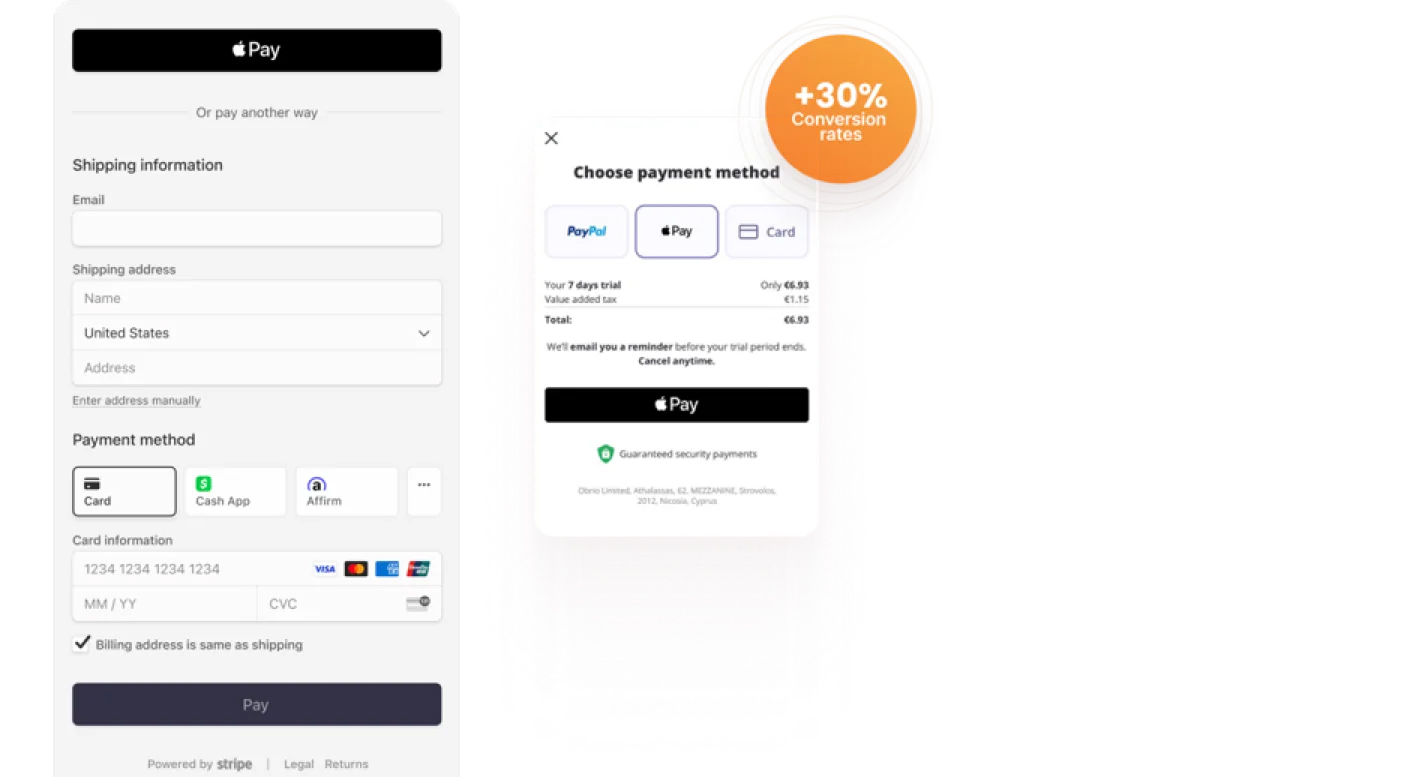
Payment setup: PSP vs MoR
You can go two ways with payments:
- A Payment Service Provider (PSP) like Stripe gives you full control and lower fees, but you handle compliance and setup.
- A Merchant of Record (MoR) like Paddle takes care of taxes, fraud, and refunds, but offers less flexibility and slightly higher cost.
Many teams use both: Stripe for cards and Paddle for PayPal and compliance coverage.
Upsells: don’t stop at one sale
The moment after purchase is a high-leverage point. Add relevant post-checkout offers: extra features, bundles, or add-ons. Even one well-placed upsell can increase LTV by 20–50%.
We put together a full guide to web2app payments covering everything: from provider selection and payment orchestration to pricing models and proven checkout tips. Download now.

5. Optimize funnel performance with A/B testing
Web2app funnel gives you full control, which means you can (and should) test everything. But testing at random won’t get you far. A/B testing a web2app funnel only pays off when you run structured experiments that directly impact revenue.
What to test:
- Onboarding: first screen, storytelling angle, personalization logic, email capture
- Paywall: trial type, pricing, plan layout, value framing, testimonials
- Checkout: layout, default payment method, security visuals, embedded vs modal
- Post-purchase: upsell timing, offer type, CTA copy
💡 To track funnel performance, use product analytics (like Mixpanel or Amplitude) to see how users move through the funnel. Connect events to ad platforms (e.g., Meta’s CAPI) and sync data between web and app via deep links or server-side. MMP isn’t required unless you’re bridging attribution into the app.
Common mistakes with web2app funnels (and how to fix them)
Mistake #1: The ad says one thing, the funnel says another
If the promise in your ad doesn’t match what happens next, users drop. High CTR with no conversions usually means the message broke between the ad and onboarding.
What to do: Make sure the ad, onboarding, and paywall tell one consistent story. Set clear expectations and then meet them.
Mistake #2: Onboarding feels generic
Users click through, but bounce early. The quiz is vague, the flow is flat, and nothing feels specific to them. If there’s no payoff, there’s no reason to stay.
What to do: Ask relevant questions, and reflect on answers. Even a small preview, like a summary or tip, can help users see the value in finishing.
Mistake #3: The paywall shows up too soon (or says too little)
A strong onboarding can still fall apart at the paywall. If it feels rushed, generic, or sketchy, users stop cold. Wrong timing kills momentum.
What to do: Show the paywall only after the value is clear. Personalize it. Keep layout simple: 2–3 clear plans, real benefits, real trust signals.
Mistake #4: The handoff to the app breaks the experience
A user pays, installs the app, and hits a login wall or empty screen. No context, no continuity, no sign of what they just bought.
What to do: Use deep links and auto-login wherever possible. Capture email or ID during checkout. And when the app opens, pick up right where the funnel left off.
Wrapping it up
A high-performing web2app funnel isn’t about one magic trick. It’s a system that gives you more control, better data, and a clearer path from interest to purchase. When built right, these funnels improve ROAS and LTV and make performance marketing measurable again. The key is consistency and continuous testing.
And the best part? You don’t need a big team to get started — just the right infrastructure.
That’s what we’ve built at FunnelFox: a no-code platform where you can launch a web2app funnel in hours, not weeks. You can assemble onboarding flows and high-converting checkouts like building blocks — using pre-built, conversion-tested components — or start from scratch with full creative control.
Switch between payment providers, set up upsells and upgrades, customize cancellation flows, and track it all in one place. FunnelFox also lets you run meaningful A/B tests with built-in analytics, so every decision is grounded in real data.
From the first click to renewals and retention, FunnelFox supports the entire web2app journey. Book a demo and see how it fits into yours.






